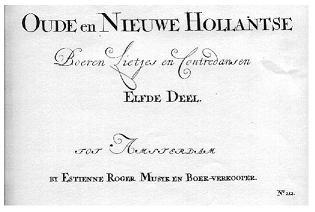| |
An
18th-century source of the 'Batali'
The
'Batali' [NVE 47] is a strange piece in Jacob van Eyck's Der Fluyten
Lust-hof. Neither a variation work nor a free fantasia or prelude,
it is a work depicting and imitating a battle. As Ruth van Baak Griffioen
suggests, van Eyck might have played his 'Batali' with the bells of
Utrecht whilst celebrating Dutch military victories. [1]
The carillonneur is known to have participated in such celebrations
at several times.
Battle pieces are usually full of clichés,
such as triadic trumpet calls, drone basses and drumbeats. Van Baak
Griffioen has analysed the 'Batali' and found a lot of similarities
between its motives and those in other selected battle pieces, by
Jannequin (his most famous chanson), Vallet (lute), Byrd (keyboard)
and other composers. The genre must have been quite popular.
|
|
| |
Under No.
789, the eleventh volume (c1715) contains a piece called 'De slag van
Pavie' ('The battle of Pavie [Pavia]'), which shares so many features
with van Eyck's 'Batali' that it seems to have been derived from it.
[Facsimile]
The concordance between the two pieces - which has eluded van Baak's
notice - raises several questions. The burning issue is: does the example
from Roger's collection rely on Der Fluyten Lust-hof, or are
the two works parallel versions of one and the same battle piece, so
deeply rooted in Dutch society that it had its place in the communal
memory of the nation?
'De slag van Pavie' is a strange heading in the light of the musical
content: the piece includes the 'Wilhelmus', in van Eyck's time a symbol
of the revolt against Philip II of Spain. Today, it is the Dutch national
anthem. The song dates from c1568. The battle of Pavia, however, had
already taken place in 1525, and had nothing to do with any Dutch revolt.
Pavia is a city in northern Italy, and the famous battle there was between
the forces of Emperor Charles V and the troops of the French king Francis
I.
It leads us to believe that 'Slag van Pavie' was a common Dutch designation
for battle pieces. This is confirmed by a diary that the schoolmaster
David Beck from The Hague kept in 1624. On 23 September of that year,
he visited the Grote Kerk, 'hoorende [...] wel een uijre lanck de slag
van Pavijen op den Orgel spelen, alwaer veel volck was' (hearing for
the duration of one hour the battle of Pavia played on the organ, attended
by many people). [3]
How do the 'Batali' and 'De slag van Pavie' relate to each other? All
sections and ingredients of van Eyck's piece are present in the later
version, except for the 'drum section' of high and low C's preceding
the 'Allarm'. The corresponding sections have the same order. The 'Wilhelmus'
tune is in triple time in both cases, and not in duple time as usual.
Are these features a matter of coincidence? It is not very likely. Another
battle piece, for lute, has survived from the 17th-century Dutch Republic.
It is by Nicolas Vallet (Secret des Muses II, 1616).
[4]
It again shows similarities too but they are less, whereas the overall
plan is utterly different. Apparently there was not one ubiquitous concept
of a battle piece making its round in the Netherlands at that time.
An organist could even sustain it for one hour, as David Beck informs
us. This gives good reason to assume that 'De slag van Pavie' does rely
on the van Eyck.
But what about the great many differences? Sometimes they are marginal,
other times considerable.
One could call 'De slag van Pavie' a corrupted and - at some places
- simplified version of the 'Batali'. It is interesting, for instance,
to see how measure 12 of the first section has been flattened out. In
Der Fluyten Lust-hof this measure is part of a sequence, and it
is the only place in the whole Lust-hof where van Eyck prescribed
the note D'''. In the 'Pavie' version this was smoothed out completely,
with only two notes C''' remaining, certainly less demanding. [example]
The last
section of 'De slag van Pavie' hardly shows any concordance with the
'Batali'. It is in triple instead of duple time, the alternation between
G' and C" in the first measures is organised differently, and little
remained of the stirring character of the original.
It is clear that the compiler of Roger's collection didn't copy the
piece straight from van Eyck's Lust-hof. The 18th-century version
seems to be the work of a musician - probably a recorder player, unable
to perform the D''' - who remembered the piece only vaguely. It is close
enough to make it identifiable as proceeding from van Eyck, but not
close enough to hold its own against the original. Perhaps the most
important lesson is that van Eyck's mental legacy was still alive even
sixty years after his death...
|
|
| |
Notes
[1]
Ruth van Baak Griffioen, Jacob van Eyck's Der Fluyten Lust-hof (1644-c1655),
Utrecht 1991:
109-113. [back]
[2]
Facsimile ed. M. Veldhuyzen, Hilversum 1972.
[back]
[3]
David Beck, Spiegel van mijn leven, Haags Dagboek
1624, Hilversum 1993: 174. [back]
[4]
Facsimile: Utrecht, 1986. Modern edition: Paris,
1970. [back]
|
|
